No flowers on cucumber plants?
A cucumber plant with no fruit is just a foliage plant.
To grow cukes, you need your plant to flower.
The first blooms are always male and there will always be more of them.
Cucumber plants and every plant in the cucurbit family produce up to 10x more male flowers than they produce female flowers.
Male and female flowers are separate on cucumber plants according to the University of Maryland.
The University of Georgia adds that the first flowers are always staminate or male flowers.
Female flowers are pistillate. This means that they have pistils but no stamens.
The female flowers require a lot of energy so the plant needs to develop a ton of huge green leaves.
You need the male flowers for pollen and the females for fruit.
Of course, when you have a cucumber plant with no flowers at all, you will never get it to grow fruit.
Table of Contents
No Flowers on Cucumber Plants
Cucumbers will fail to bloom when they lack energy. The leaves need to be green for photosynthesis, and the soil must be rich in nutrients. Adding blood meal to the soil boosts nitrogen and phosphorous. It needs high temperatures for male flowers and cooler temperatures for female flowers.
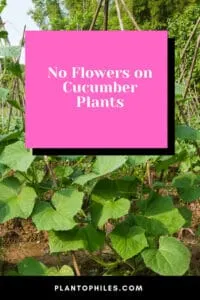
No Flowers on Cucumber Plants
Understanding the flowering process on cucumber plants
The fruits of cucumber plants grow from female flowers. Male flowers produce pollen, female flowers grow fruit.
The female flowers will only produce fruit when it is pollinated by either cross-pollinators like bees and butterflies, or by doing it manually using an artist’s paintbrush or something similar.
The pollen will not spread by the wind. If your garden lacks pollinators, you will likely need to pollinate the flowers by hand.
Female flowers open in the morning, just after sunrise, and stay open for around 5 hours. If they are not pollinated within 2 to 3 days, they close up then drop off.
All plants in the cucurbit family produce more male flowers than females.
The males emerge first as those do not need as much energy.
As the female flowers are the fruit bearers, they need lots more energy.
Green leaves on the plant are how it gets enough energy to produce flowers.
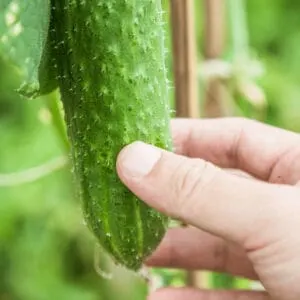
Fruits grow from female cucumber flowers
The temperatures cucumbers need for flowering
High temperatures promote male flower production. Cooler temperatures promote female flowering.
When temperatures are 86-Fahrenheit and warmer, male flowers grow.
Cooler than 60-Fahrenheit is when female flowers emerge.
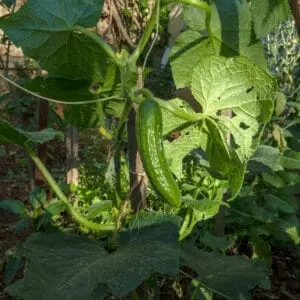
Only temperatures cooler than 60 degrees Fahrenheit produce female flowers
How to tell the difference between male and female flowers
Male flowers have stamens, female flowers have a stigma. Males always grow on cucurbits first.
The easiest way to tell the difference is to look at the part of the plant that the flower is attached to.
Female flowers grow on fruit. Male flowers grow on stems.
The flowers need to stay on female flowers for the pollen to help fruit growth.
The male flowers produce the pollen that the female flowers need for growth.
It’s how plants reproduce, or in the case of cucumbers, grow delicious fruits.
If you find your cucumbers have very few female flowers, picking off some male flowers can encourage female flowers to grow, provided the temperatures are cooler.
When there is a lack of beneficial insects (ants, bees, beetles, moths, and butterflies) cross-pollination will need to be done by hand.
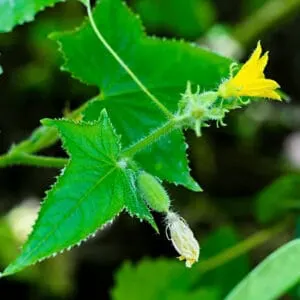
Male flowers have stamens and grow from stems
Nutrient requirements for cucumbers to flower
For the plant to have the energy it needs to produce flowers, the soil needs the right acidity.
A pH of around 6.5, and rich in nitrogen and phosphorous is what is needed for flowering.
The more nitrogen there is, the greener the leaves will be.
You need the majority of the leaves to be green for the plant to photosynthesize. It is how it makes food for energy.
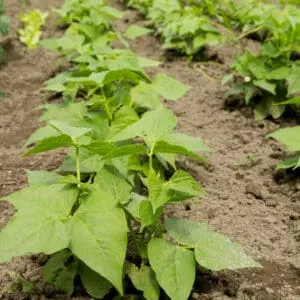
Cucumber plants need lots of nitrogen and phosphorus for flowering
When cucumbers lack energy, they will not bloom
Anything stressing the cucumber plant results in fewer blooms and that restricts its fruit growth.
Two things contribute to boosting blooms. Nitrogen and phosphorous.
Phosphorous is the driver for flowering and that is what drives fruit production.
Nitrogen promotes the green in the leaves that helps the plant produce energy internally through photosynthesis.
One of the richest sources of both nutrients is blood meal.
A little of this goes a long way in garden soil.
An added advantage to using blood meal is the scent of it can deter some wildlife.
In gardens with mole problems, squirrels nibbling in your vegetable patch of wild rabbits, or even deer, blood meal can be a good deterrent.
It is a slow-release fertilizer so you do not need to add it often. Once early in the season will be sufficient to last a few months.

Planting a cucumber plant
Too much of it though can increase the soil acidity to the extent it burns the plants, which can kill it.
Use blood meal sparingly and only as a booster.
For regular feeding, the best fertilizers for vegetables will depend on the stage of growth.
A phosphorus-rich fertilizer can boost flowering, but that is determined by your existing soil nutrients.
Too much fertilizer will change the soil pH. When that happens, it is handy to know how to pH up and down in soil to ensure your plants get the nutrients they should be.
Ensure the whole plant gets a healthy dose of sunlight
Sunlight is how you keep the leaves on cucumber plants healthy. They do not grow well in the shade.
The absolute minimum sunlight requirements are 5 to 6 hours full sun. For lush growth though, aim to grow cukes in a location that gets 8 to 9 hours of full sun.
Vining varieties of cucumbers do better because more of the leaves are exposed to sunlight. O
n bush varieties that stay close to ground level, much of the leaves will be shaded.
Bush varieties of cucumbers will need more sunlight exposure than vining varieties.
On both types, be aware of blanching. This happens when the top leaves shade the lower leaves causing bottom leaves on the cucumber plant to turn white, or pale yellow.
When you have partially white leaves on cucumbers caused by blanching, selective pruning to open the canopy to more sunlight exposure can correct the problem.
Diseases that drain the plant of energy
Whenever cucumbers are lacking flowers, look for anything that could be depleting their energy.
Good places to start inspecting for foliage damage is the underside of lower leaves. This is where mites will feed.
Sap-sucking insects cause yellow spots on cucumber plants. Insects suck the life out of plants, draining them of the energy needed for photosynthesis.
Aphids, spider mites, and thrips can be blasted with a strong jet stream from a garden hose. Larger insects like beetles can be picked off the leaves or knocked off to the ground.
Severely damaged leaves may be better pruned for new healthy leaves to grow in.
When trying to promote flowering though, do not trim the plant back too much. The fewer green leaves there are, the less chance there will be of it flowering.
Fungal and bacterial infections that hinder the flowering process
Any fungal or bacterial infection on any part of the plant will drain its resources.
Powdery mildew blocks sunlight causing leaves to turn chlorotic, while all other fungal and bacterial infections will cause brown spots on cucumber leaves that eventually lead to defoliation.
Any infections need to be treated with a fungicide, preferably something friendly to the bee population. Kill the pollinators, any flowers that do grow in will quickly wither, close, and drop if you do not hand-pollinate early in the morning.
Frequently Asked Questions About No Flowers on Cucumber Plants
How do I hand pollinate cucumber flowers?
Pinch the male flower, remove the petals, then gently dab the stamen into the stigma of the female flower. If you would rather not remove the flowers, the alternative is to dab a thin bristled paintbrush onto the male flower, then rub the bristles onto the stigma of the female flower.
Why are all the flowers female with no male flowers?
Hybrid varieties of cucumbers (gynoecious) are cultivated for higher crop yield. The flowers are predominantly female but they do still need male flowers for pollination. Most hybrid varieties have upwards of 80% gynoecious seed for female flowering with under 20% monoecious seed for pollination.

Daniel has been a plant enthusiast for over 20 years. He owns hundreds of houseplants and prepares for the chili growing seasons yearly with great anticipation. His favorite plants are plant species in the Araceae family, such as Monstera, Philodendron, and Anthurium. He also loves gardening and is growing hot peppers, tomatoes, and many more vegetables.


